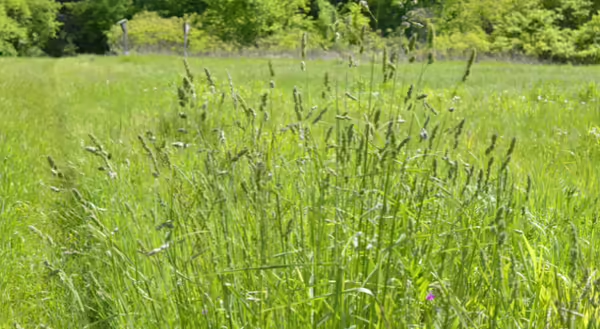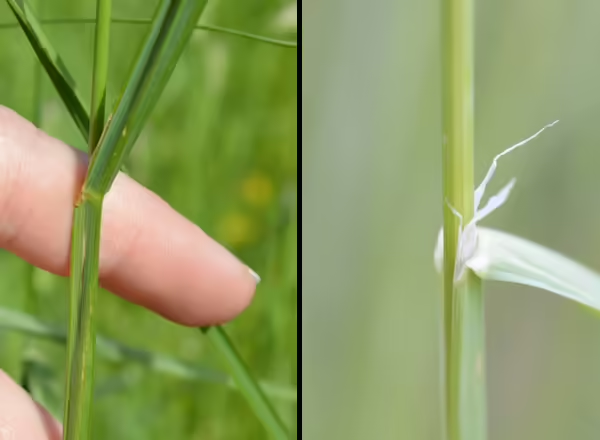
As we enter May, many cool-season grasses are beginning to flower, which makes them a bit easier to identify. One such grass is a European pasture and hay grass called Orchard Grass, Dactylis glomerata. This non-native grass has been used in agriculture for centuries and can persist in old fields, while also growing along roadsides and in other disturbed areas.
This grass can be found throughout Illinois, so it’s likely that you’ve seen it before even if you didn’t know what it was. Prairie restorations on former farmland are a prime spot to find this grass.

How to identify before it flowers
Orchard Grass typically grows 3 to 4 feet tall, forming bunches. It is rhizomatous and can spread over time. Its leaves and leaf sheaths are keeled, meaning it looks like they were folded in half and retain a crease. Oftentimes the leaves found near the top of the plant are held 90 degrees away from the stem. The ligule is distinct on this grass – it is a very tall, membranous ligule, but it doesn’t stay in one piece. It often looks like it has been ripped into smaller pieces.

Taking a closer look at the flowers
Orchard Grass produces a panicle inflorescence, with branches that have clusters of spikelets near their tips, with the base and middle of the branches bare. The clusters of spikelets look fluffy or bushy. They can be green to purple in color, and the spikelets do not have awns. When mature, some of the branches of the inflorescence are held 90 degrees away from the rachis (central stem of the inflorescence).
How did it get its name?
A final note – why the name Orchard Grass? My research led me to find that about 200 years ago, farmers in Virginia noticed that this grass grew well under the shade of the trees in their orchards and served as a forage grass, a unique combination. Hence, Orchard Grass!
Never miss a new post! Sign up for our email list.
ABOUT THE AUTHOR: Erin Garrett is a Natural Resources, Environment, and Energy Educator for University of Illinois Extension serving Alexander, Johnson, Massac, Pulaski, and Union counties. Erin develops and delivers high impact programming to adults and youth to help them develop an appreciation for natural resources and to empower them to make small changes to positively impact the environment. Erin’s programming focuses on why homeowners should consider choosing native plants, how to support native pollinators, how to identify grasses, how to identify and manage invasive species, and developing an appreciation for prairie ecosystems.
ABOUT THE BLOG: Grasses at a Glance dives into grass identification, focusing on tips and tricks that make grass identification possible. Get information about native and non-native species, how to tell look-alikes apart, and which grasses you can find in Illinois.
Orchard Grass, Dactylis glomerata, is a non-native cool season grass that grows in old fields, pastures, and disturbed areas. When identifying this grass, look for the open leaf sheath, as well as the tall membranous ligule. This ligule can range from white to yellow in color and what...